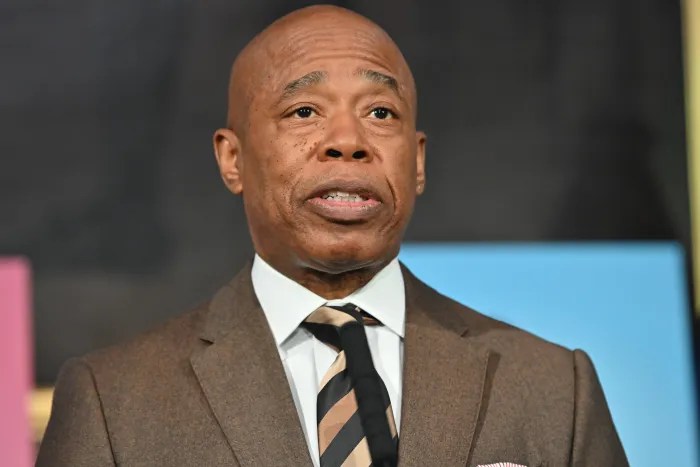
Matt Green, Director of Participatory Budgeting for Councilmember Johnson, goes over the process with residents of the 3rd Council District.
BY SEAN EGAN | Have you ever wished that you could have a real, direct say in how your tax dollars are spent in your community? That’s exactly what Participatory Budgeting strives to do — and on June 26, the office of District 3 Councilmember Corey Johnson held a meeting to spread the word about this radical, relatively new city program that will put money in the hands of communities like never before. Over the course of the early evening meeting on the High Line, representatives from Johnson’s staff addressed the District 3 residents who came out, and explained exactly what Participatory Budgeting (PB) is, and how the community can get involved in the process going forward.
By 6 p.m., a sizable crowd of people had gathered in the office space of the Friends of the High Line overlooking the park. The meeting began with general introductions. While Johnson himself was not in attendance, the meeting was headed by Matt Green, the office’s PB Director, Jeffrey LeFrancois, Johnson’s Chief of Staff, and Christopher King, a Community Engagement Strategist from Community Voices Heard.
After these general introductions, Green, who had previously aided the PB process in Brooklyn and described it as an “amazing, positive experience,” queued up an informational slideshow — kicking the night off with an icebreaking game of “Jeopardy” to gauge audience knowledge of participatory budgeting, featuring categories such as “NYC Budget Basics” and “Discretionary Funds.” The crowd murmured and called out responses to the questions, sometimes shocked by the correct answers. After the game piqued their interest, Green played a short video (in which he made a cameo appearance) on the purpose and benefits of participatory budgeting (available for viewing at pbnyc.org).

Try Budget Basics for 300, in the Participatory Budgeting version of “Jeopardy.”
Following the game of Jeopardy and the video, a working definition of what participatory budgeting is had been reached — it is the democratic process by which communities decide how a portion of the city’s capital budget is spent (on things such as improving parks, sidewalk beatification and public school upgrades). The practice started in Brazil, and eventually spread to North American cities, like Toronto, and three years ago, New York City. Now, in this fiscal year, 22 NYC Council Districts are participating — “Larger than any city that’s doing PB anywhere,” noted Green proudly.
District 3 alone has been allotted $1 million for the completion of various community projects of the people’s discretion — and Johnson’s office is excited about the possibilities. As Josh Lerner of the Participatory Budgeting Project puts it in the video, participatory budgeting “Gives people real power over real money, to make the decisions that affect their lives.”
The other goals of participatory budgeting, according to the slideshow, include: Opening up government, expanding civic engagement, developing new community leaders, building communities, and making public spending more equitable.
With a basic understanding of PB under the crowd’s belt, Green and company fired ahead with the presentation, getting more into the nitty gritty of the PB process. Starting with general neighborhood assemblies, community residents are encouraged to bring forth ideas for public improvement — with nearly 300 sometimes resulting from these meetings. Next, budget delegates are selected to learn about the budgeting process, and then take the ideas and whittle them down and refine them with support from the Councilmember and their office. In addition, District Committees are formed to help run the process in each individual district. Once the ideas have been refined into workable proposals (usually about 30 or so after the initial ideas are vetted), they are brought back to the community to examine them and, eventually, vote on their favorites to be implemented with the money set aside for participatory budgeting — with the top five vote getters being funded.
Green then pulled up a helpful, circular flow chart that outlined the exact timeline for the steps of the PB process. Initial neighborhood assemblies for ideas happen in September and October, while delegate meetings and proposal development takes place from November to February. So-called Project Expos, where delegates present their ideas in a public space, using posterboard and diagrams (“It’s fun — like a science fair,” asserted Green) take place around February and March. March to April sees the community vote, a process which takes place over the course of a week or so at various pop-up locations in the district, and through Councilmember Johnson’s office. After the vote comes the implementation.
With the first neighborhood assemblies quite a ways away, the main purpose of the meeting was to gauge community interest and raise awareness of PB — and those running the meeting were sure to stress the important role of the community in driving the PB process forward. “There’s no way you can’t be helpful — we’ll find a way for you to help!” quipped LeFrancois to the crowd’s amusement. Indeed, in line with PB’s inclusive, democratic spirit, it seems there is a way for everyone to get involved.
To be a budget delegate, and help shape and propose ideas, one only needs to be 14 years old, and live, work, attend school, or own a business in the district. Voting requirements are similarly open — you need to be 16 and be able to prove you live in the district (no voter registration or proof of legal status is required). One can also volunteer to be a part of the District Committees, or simply attend meetings. Beyond that, raising community awareness of this fledgling program is crucial to the process. “When does outreach happen? The whole time!” joked King, whose job involves making the PB process run as smoothly as possible for the communities. King mentioned that he would help run trainings on outreach for those who are inexperienced or nervous. He also described an outreach process that would fire on all cylinders, including email blasts, mailers, going door-to-door and phone banking. In addition, some fundraising is required to provide volunteers with necessary supplies and services to keep the project running along.
Green, LeFrancois, and King ended the session by opening up the floor to questions. A good deal of hands shot up, looking for clarification on certain matters. Most frequently, people asked about the status of non-profit organizations, and if they could receive funding from PB. Green noted that not-for-profits did not fall under the umbrella of PB, insisting that PB was designed for a “long term investment in infrastructure” to benefit the community as a whole. In addition, concerns were raised about how the dispersion of the projects would shake out, given the diversity of District 3, which stretches from Canal to 62nd St. King, LeFrancois, and Green assured the crowd that the Councilmember’s office and the District Committees would work hard to develop a slate of projects that would benefit as many different neighborhoods of District 3 as possible.
When one person inquired about the role of Community Boards in the PB process, they were told that it varies board by board in terms of how much time and effort they’d like to commit — though LeFrancois noted, with a laugh, that “There’s a lot of good board representation in this room right now.”
Shortly thereafter the meeting adjourned, with King, LeFrancois, and Green urging attendants to get involved and spread the word about participatory budgeting.
The next Participatory Budgeting meeting takes place on Tuesday, July 29, at 6:30 p.m., at Hudson Guild (441 W. 26th St., btw. Ninth & Tenth Aves.). For more info, contact Matthew Green by calling 212-564-7757 or send an email to mgreen@council.nyc.gov.




































